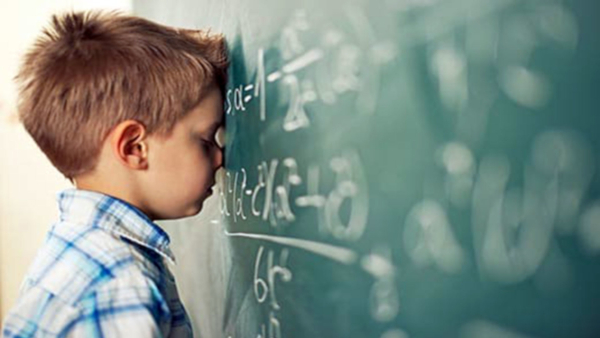Dyscalculia, also known as Development Dyscalculia, is a neurological condition that affects school-level mathematics skills. Some children with dyscalculia cannot grasp basic number concepts and work hard to memorize them, however inadvertently miss the logic behind the concepts. Some children may understand the logic but struggle with the application of the concepts. Children with dyscalculia may be performing well in other subjects but struggling in math. They often fall behind in primary schooling and are unable to catch up without proper intervention.
The American Psychiatric Association defines dyscalculia as a ‘mathematical disability’. Those with the condition have a, ‘…mathematical ability, as measured by individually administered standardized tests, is substantially below thatexpected, given the person’s chronological age, measuredintelligence, and age-appropriate education, whichsignificantly interferes with academic achievement oractivities of daily living that require mathematical ability,’
The most common problem is with ‘number sense’. This is an intuitive understanding of how numbers work, and how to compare and estimate quantities on a number line. This means children with dyscalculia are unable to understand number words (one, two, twelve, twenty), numerals (1, 2, 12, 20) and therelationship between them (i.e. which quantity is greater or less than the other etc.), struggle with understanding the number line and the logic behind its sequencing. These issues further evolve into difficulties carrying out basic mental math, the application of the four concepts of addition, subtraction, multiplication and division, struggles with the ‘missing operand problems’(13+?=46), difficulties with word problems, and eventually, struggling with money and time management etc.
Studies show that even babies have a basic sense of numbers. Dr. Brian Butterworth, a leading researcher in dyscalculia, compares number sense to being color-blind. He says some people are born with number blindness. This makes it hard to tell the difference between quantities. Number blindness is one reason many kids have trouble connecting numbers to the real world. They can’t grasp the idea that ‘five cookies’ has the same number of objects as ‘five cakes’ and ‘five apples’.
Source: UNESCO MGIEP, www.understood.org
Dyscalculia is an under-studied condition with research on dyslexia outnumbering that on dyscalculia by 14:1 despite having the same prevalence as dyslexia. Thus, the exact causes for dyscalculia cannot be pointed and differ from person to person. However, following is a list of potential causes.
- Genetic: Researchers have found that a child with dyscalculia often has a parent or sibling with similar math issues. Turner’s syndrome, Fragile X syndrome, Velocardiofacial syndrome, Williams syndrome are some of the genetic disorders that have been observed in people with dyscalculia. Certain genes in the population people put members at high-risk of dyscalculia.
- Braindevelopment: Researchers are using modern brain imaging tools to study for a comparative analysis of people with and without dyscalculia. Such researches have observed a difference in the gray matter, surface area, thickness, volume of parts of the brain that are associated with learning, memory and cognitive capacities. Research in ‘special populations’ such as babies with Turner’s syndrome shows the presence of less brain cells or gray matter in those parts of the brain that are known to process mathematics.
- Environment: Dyscalculia has been linked to exposure to alcohol in the womb. Prematurity and low birth weight may also play a role in dyscalculia. All of these may cause delayed brain development.
- Braininjury: Studies show that injury to certain parts of the brain can result in what researchers call ‘acquired dyscalculia’.
It is important to remember that trouble in math is not necessarily always caused by dyscalculia. It can also be a lack of instruction, opportunity, a side effect of anxiety, depression and other mental health issues, math anxiety, or dyslexia that is being masked by instruction in a phonetically-consistent language. An in-depth assessment of the child is important to ensure that there is no misdiagnosis.
Children with dyscalculia begin to rely heavily on physically counting everything to make sense of the calculations. This is harmful as this will disrupt their understanding beyond a certain basic level. Children struggle withautomatically recalling an answer that they have already arrived at and fall into the habit of counting up, often on their fingers, to calculate the answer over and over again. This mechanical method takes time and effort which puts an undue strain on working memory, which in turn prevents connections being made between the question and the answer.
Children with dyscalculia must be prevented from falling into this ‘Counting trap’. By teaching them innovative and compressed calculation tactics, their brains can be ‘rewired’ to perform math at a faster and less tedious pace. At a young age this can be done through games, visual aid and other toolkits that teach them to recognize quantity and associate it successfully with numeric symbols. This will take time but it is extremely important.
Parents, teachers and tutors need to ensure a child doesn’t fall into this trap.
Here is a helpful video on how to deal with the ‘counting trap’: https://www.youtube.com/watch?v=GstqJ5sEEoo
Conditions that often exist with—or are misdiagnosed as—dyscalculia are:
- Dyslexia: Children are often diagnosed with dyslexia and dyscalculia. Researchers have found that 43–65 percent of children with math disabilities also have reading disabilities.
- ADHD: Children are often diagnosed with dyscalculia and ADHD. But some math errors can be explained by inattention to detail and other characteristics of ADHD. As a result, some experts recommend reevaluating math skills after getting ADHD symptoms under control.
- Math anxiety: Children with math anxiety are so worried about the prospect of doing math that their fear and nervousness can lead to poor performance on math tests. Some children may have both math anxiety and dyscalculia. Math anxiety does not mean that the child is struggling with a conceptual understanding, but are in fact feeling pressurized to perform well, causing them to have poor math skills.
- Genetic disorders: Dyscalculia is associated with several genetic disorders including fragile X syndrome, Gerstmann’s syndrome and Turner’s syndrome.
Source: www.understood.org
Dyscalculia and Dyslexia are two separate conditions with distinct characteristics and over-lapping symptoms. While it may seem easy to confuse the two, there are several fundamental differences. Dyslexic children flip numbers, mess up places of numbers in larger quantities, and misread arithmetic symbols. Their condition affects their reading abilities. But they can gain a conceptual understanding and are, in fact, known to recognize broader patters in math that an average student may not. They donot have issues with the conceptual understanding in arithmetic calculations. Einstein and Beethoven are two examples of dyslexics with impeccable mathematical abilities. While Einstein’s success needs no reiteration, Beethoven may seem a more peculiar example. Music theory does have several mathematic concepts at its base. Beethoven, with his ability to recognize larger patterns, was able to create beautiful symphonies. Children with dyscalculia, like those with dyslexia, also have trouble with sequential memorizing but, unlike dyslexics, they struggle with conceptual arithmetic understanding – patterns, quantities, comparisons etc.
This is an important difference as dyslexia in children learning in phonetically-consistent languages may get masked but the symptoms may come out while learning math. In such situations, it is important to recognize whether the child has dyslexia or dyscalculia for an effective treatment. If it is dyslexia, it is the language and reading short-comings that need to be tackled, while dyscalculia requires an entirely different treatment.

